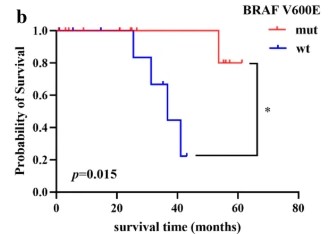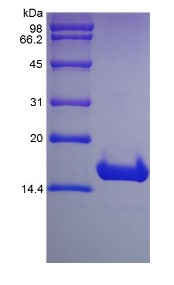CDKN2A
-
Official Full Name
cyclin-dependent kinase inhibitor 2A -
Overview
The gene for CDK2NA generates several transcripts/proteins which differ from each other in their first exons. Three of these transcripts are generated by alternative splicing (isoform 1 a.k.a p16INK4A, isoform 2 and isoform 3 a.k.a p12), two of which are known to function as inhibitors of CDK4 kinase. One other transcript that is generated from this gene contains an alternate reading frame (ARF), with the first exon located 20kb upstream of the remainder of the gene(isoform 4 a.k.a. p14ARF, p19ARF, ARF). In spite of the structural and some functional differences, all the proteins encoded by the CDKN2A gene are involved in cell cycle G1 control. -
Synonyms
CDKN2A;cyclin-dependent kinase inhibitor 2A;Arf;p16;MTS1;Pctr1;p19ARF;p16INK4a;p19<ARF>;ARF-INK4a;INK4a-ARF;Ink4a/Arf;p16(INK4a);cyclin-dependent kinase inhibitor 2A, isoform 3;CDK4I;p16-INK4;p16-INK4a;mitochondrial smARF;cyclin-dependent kinase 4 inhibitor A;cyclin-dependent kinase inhibitor protein;cyclin-dependent kinase inhibitor 2A, isoforms 1/2;cyclin-dependent kinase inhibitor 2A (p16, inhibits CDK4)
Recombinant Proteins
- Human
- Rat
- Mouse
- Chicken
- E.coli
- Wheat Germ
- Mammalian Cells
- HEK293
- In Vitro Cell Free System
- GST
- Non
- TAT
- His
- T7
- Avi
- Fc
- Flag
Background
What is cdkn2a protein?
CDKN2A (Cyclin Dependent Kinase Inhibitor 2A) is a protein coding gene that plays a crucial role in regulation of the cell cycle, specifically in the transition from the G1 to the S phase. The protein that the CDKN2A gene codes for chiefly functions as a tumor suppressor, that is, it prevents cells from growing and dividing in an uncontrolled way. Mutations in this gene can lead to several types of cancer, including familial melanoma, pancreatic cancer, and lung cancer.
The protein produced by the CDKN2A gene is known as p16 or p16INK4a. This protein works by binding to a complex formed by CDK4 or CDK6 and cyclin D, effectively inhibiting the enzymatic activity of CDK4/6 and hence preventing the cell cycle progression.
In terms of its discovery, CDKN2A was first reported in 1994 by several research groups who identified its deletion or mutation in several types of cancers. Originally identified as a protein inhibiting CDK4 (thus the name INK4), the discovery of its role in cancer has led to it being one of the most extensively studied genes in the fields of cancer biology and genetics.
As for its structure, p16INK4a is a member of the INK4 family of proteins which consist of several ankyrin repeats. Ankyrin repeats are a common structural motif in proteins and are composed of two alpha helices separated by loops. In the case of p16INK4a, the protein has four ankyrin repeats, which contribute to its function by allowing it to bind to CDK4/6. Also noteworthy is the gene's location on chromosome 9p21, a region often found deleted in various types of cancer.
What is the function of CDKN2A protein?
CDKN2A (Cyclin Dependent Kinase Inhibitor 2A) protein is a tumor suppressor protein that is involved in regulating the cell cycle. More specifically, it prevents the cell from entering the S phase (where DNA is replicated) from the G1 phase (the step before replication) until the cell is ready to replicate its DNA. This allows the cell to repair any DNA damage before replication and prevents the replication of damaged DNA, thereby preventing the development of cancer. Mutations in the CDKN2A gene that reduce or eliminate the function of this protein can allow cells to grow and divide in an uncontrolled way and can contribute to the development of cancer.
Cdkn2a related signaling pathway
RB tumor suppressor pathway: When induced, p16INK4a binds and inhibits CDK4/6, preventing phosphorylation of RB protein. Unphosphorylated RB remains bound to E2F transcription factors, blocking cell cycle progression from G1 to S phase.
p53 tumor suppressor pathway: Oncogene-induced cellular stresses can trigger p16INK4a expression via p53, inducing senescence by blocking CDK4/6. This enforces permanent cell cycle withdrawal.
AKT/mTOR pathway: Inhibition of CDK4/6 by p16INK4a decreases release of feedback inhibition on PI3K/AKT signaling. Lowered AKT activation subsequently reduces mTORC1 activity, impacting protein synthesis and cell growth.
CDKN2A Related Diseases
- Cancer predisposition: CDKN2A mutations are associated with increased risk of developing numerous cancers like melanoma, pancreatic cancer, and glioma.
- Familial melanoma syndrome: Germline mutations in CDKN2A significantly predispose to hereditary melanoma.
- Pancreatic cancer: Somatic mutations and deletions in CDKN2A are frequently observed in pancreatic ductal adenocarcinoma.
- Glioma: Reduced p16INK4a expression due to promoter methylation promotes glioma development.
- Activation holds promise against cancers with CDKN2A loss.
- Biomarker: Expression/mutation analysis aids prognosis, surveillance of cancer progression/recurrence in melanoma, pancreatic cancer etc.
- Diagnostics: Genetic testing for CDKN2A variants helps diagnosis of familial cancer syndromes like melanoma syndrome.
- Drug development: Screening drugs that can induce CDKN2A to trigger senescence in cancer cells or slow aging.
- Activation holds promise against cancers with CDKN2A loss.
- Biomarker: Expression/mutation analysis aids prognosis, surveillance of cancer progression/recurrence in melanoma, pancreatic cancer etc.
- Diagnostics: Genetic testing for CDKN2A variants helps diagnosis of familial cancer syndromes like melanoma syndrome.
- Drug development: Screening drugs that can induce CDKN2A to trigger senescence in cancer cells or slow aging.
Case Study
(Yuan Tian, 2022)
Fig2. Effects of the amount of template DNA on the efficiency of PCR amplification for amplicons in the CDKN2A and GAPDH genes (left chart) and detection of the relative CDKN2A gene copy number (right chart). The p-value in Student's t-test is labelled for each template titration.

(Lei Lou, 2022)
Fig3. The presence of BRAF V600E mutation in PXA was associated with better prognosis BRAF V600E (log rank p* < 0.05). OS was not significantly stratified by CDKN2A HD.
Quality Guarantee
High Purity

Fig1. SDS-PAGE (Cat. No.: CDKN2A-10H)
Involved Pathway
CDKN2A involved in several pathways and played different roles in them. We selected most pathways CDKN2A participated on our site, such as Apoptosis,Apoptosis Modulation and Signaling,Bladder cancer, which may be useful for your reference. Also, other proteins which involved in the same pathway with CDKN2A were listed below. Creative BioMart supplied nearly all the proteins listed, you can search them on our site.
| Pathway Name | Pathway Related Protein |
|---|---|
| Cellular Senescence | HIST1H1B,RBBP7,HIST1H1E,KAT5,SCMH1,HTATIP,CABIN1,POT1,CDKN2B,TERF2 |
| Apoptosis Modulation and Signaling | PTRH2,DIABLO,HN1,BCL2L10,HRK,BLK,CASP2,CAPNS1,DAXX,BIK |
| Cell Cycle, Mitotic | CDK5RAP2,CENPL,POLD3,MASTL,NSL1,STAG2,ESCO1,CCDC99,CENPP,DCTN3 |
| Cell cycle | HJURP,DULLARD,CDT1,PHF8,CEP76,SUN1,LIN9,ARF1,ORC4L,ORC3 |
| Apoptosis | PPP3CB,CASP10,PIK3R2,FASLG,HELLS,GZMC,TRP53,APAF1,DIABLO,TRADD |
| Bladder cancer | RAF1,SRC,HRAS,EGF,ERBB2,CDH1,CCND1,DAPK3,RPS6KA5,FGFR3 |
| Cellular responses to stress | WIPI1,HIST4H4,HIST1H1C,RBBP4,CBX8A,EGLN1B,AGO3,C11orf73,HIF1AN,IGFBP7 |
Protein Function
CDKN2A has several biochemical functions, for example, DNA binding,MDM2/MDM4 family protein binding,NF-kappaB binding. Some of the functions are cooperated with other proteins, some of the functions could acted by CDKN2A itself. We selected most functions CDKN2A had, and list some proteins which have the same functions with CDKN2A. You can find most of the proteins on our site.
| Function | Related Protein |
|---|---|
| DNA binding | DNA2,RFX2,ZNF791,SFPI1,HIST3H3,PNN,OLIG3,IRX3B,PCBP4,TFDP1B |
| NF-kappaB binding | HDAC3,NFKBIA,NFKBID,FOXP3,HIF1AN,HSPA6,RPS3,BCL10,COMMD6,EP300 |
| transcription factor binding | NFKBIA,PURA,CXXC5,SORBS3,HHEX,CD34,GTF2F1,TP53,TP73,TAF7 |
| p53 binding | ZNF385D,RCHY1,ZNF346,BCL2L12,TAF3,TRIAP1,CREBBP,BANP,RFWD3,SMARCA4 |
| cyclin-dependent protein serine/threonine kinase inhibitor activity | CDKN2C,HEXIM1,CDKN1B,CDKN1D,CDKN1BB,CDKN1BA,CDKN2B,CDKN1C,CDKN1A,HEXIM2 |
| MDM2/MDM4 family protein binding | CAV1,RFWD3,PSME3,TRP53,CDK5RAP3,PPARA |
| protein kinase binding | NGFRAP1,SCN5A,CDK5RAP3,PAX6,TPCN2,FGFR1OP,B4GALT1,CDC25B,DBF4B,CDC25A |
| protein binding | DHX9,AHNAK,TFF2,CELSR1,FAM151B,FCHSD2,ANP32B,DNAJC11,CSPG5,INPP5A |
| poly(A) RNA binding | FASTKD5,RPS27A,FRG1,SAP18,FNDC3A,UCHL5,ETF1A,ENO1,BCLAF1,HNRNPC |
Interacting Protein
CDKN2A has direct interactions with proteins and molecules. Those interactions were detected by several methods such as yeast two hybrid, co-IP, pull-down and so on. We selected proteins and molecules interacted with CDKN2A here. Most of them are supplied by our site. Hope this information will be useful for your research of CDKN2A.
CDK4;CDK6
Resources
Research Area
Related Services
Related Products
References
- Bettington, ML; Walker, NI; et al. A clinicopathological and molecular analysis of 200 traditional serrated adenomas. MODERN PATHOLOGY 28:414-427(2015).
- Ruiz, C; Li, JL; et al. Limited genomic heterogeneity of circulating melanoma cells in advanced stage patients. PHYSICAL BIOLOGY 12:-(2015).



